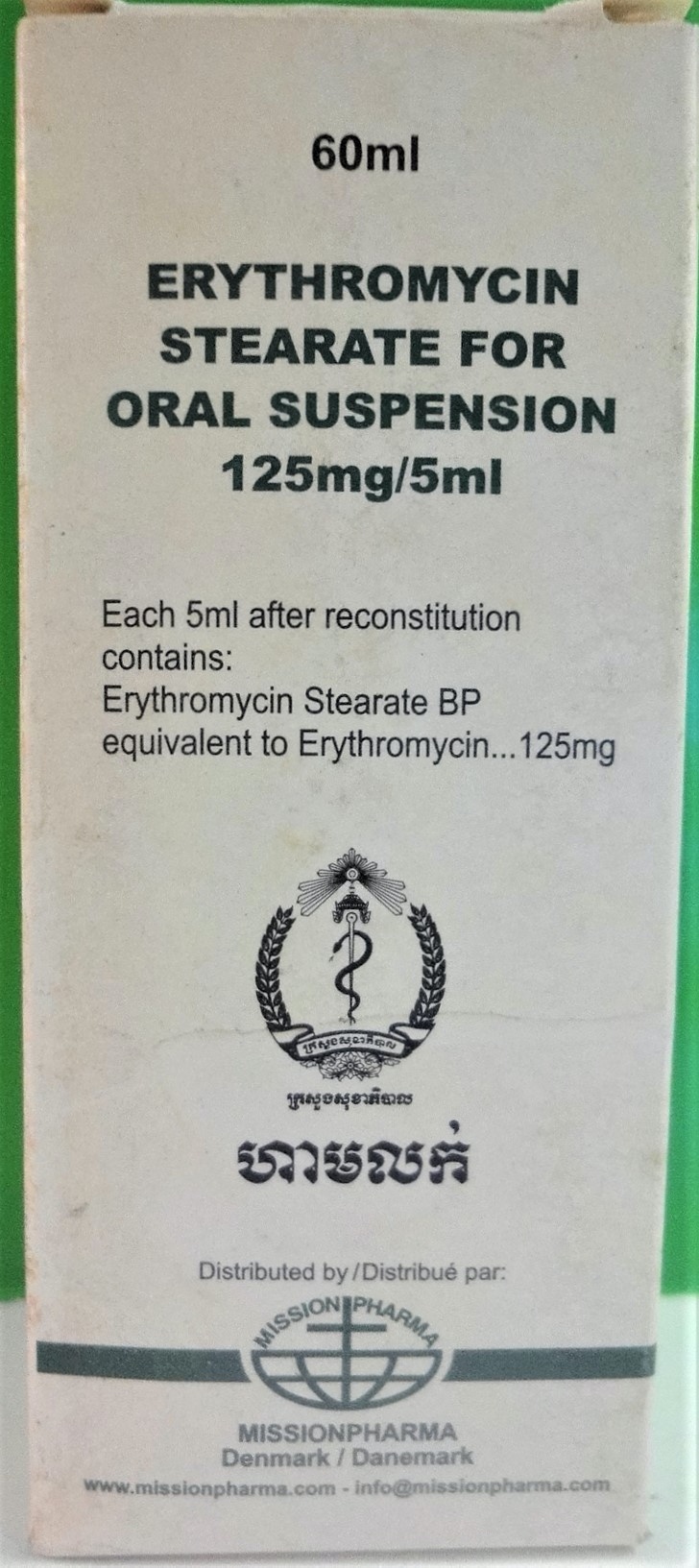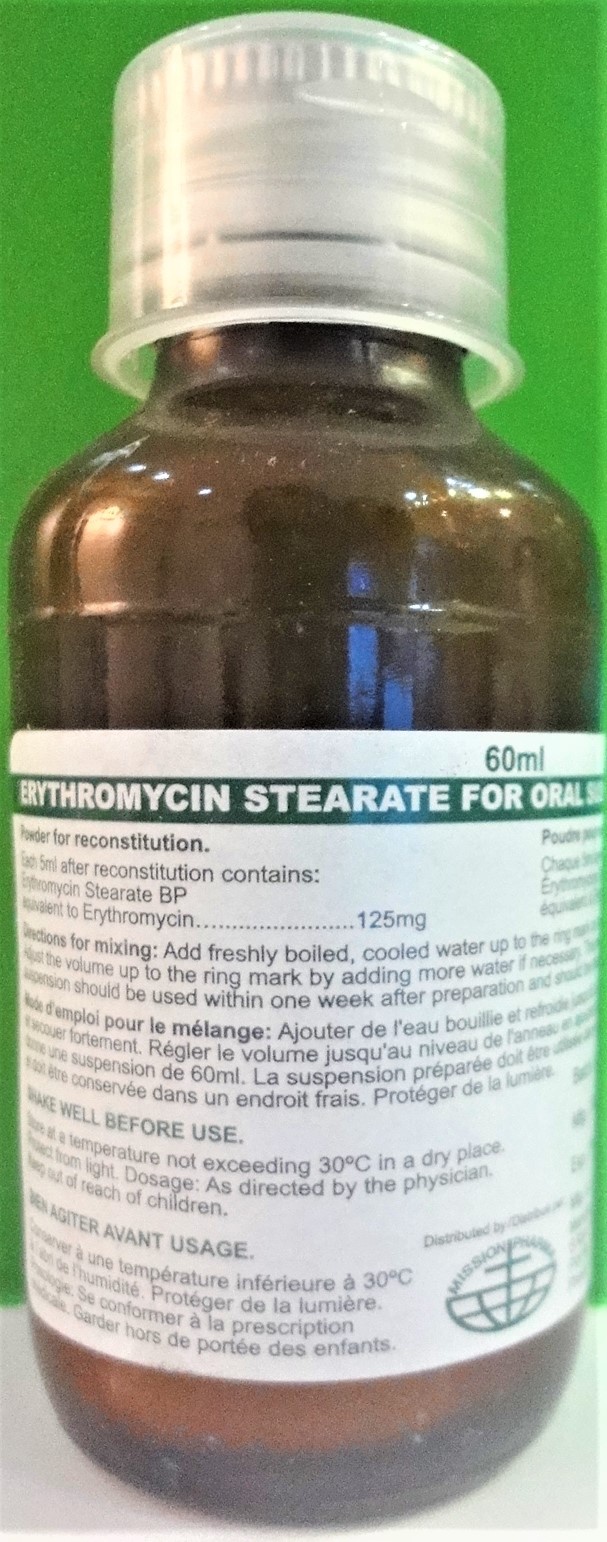ERYTHROMYCIN STEARATE Powder for suspension
ក្រុមហ៊ុនផលិតឱសថ:
S Kant HEALTHCARE Ltd., India


- សារធាតុសកម្ម
- ប្រសិទ្ធិភាពព្យាបាល និង កម្រិតប្រើប្រាស់
- ហាមប្រើ
- ផលរំខាន
- អន្តរប្រតិកម្ម
- ស្ត្រីមានផ្ទៃពោះ និង ស្ត្រីបំបៅដោះកូន
- ការប្រុងប្រយ័ត្នជាពិសេស
- សកម្មភាពឱសថ បរិយាយប័ណ្ណឱសថ
-
សារធាតុសកម្ម
Erythromycin 125mg/5mL
-
ប្រសិទ្ធិភាពព្យាបាល និង កម្រិតប្រើប្រាស់
Erythromycin is highly effective in the treatment of a great variety of clinical infections such as:
1. Upper Respiratory Tract infections: tonsillitis, peritonsillar abscess, pharyngitis, laryngitis, sinusitis, secondary infections in influenza and common colds
2. Lower Respiratory Tract infections: tracheitis, acute and chronic bronchitis, pneumonia (lobar pneumonia, bronchopneumonia, primary atypical pneumonia), bronchiectasis, Legionnaire’s disease
3. Ear infection: otitis media and otitis externa, mastoiditis
4. Oral infections: gingivitis, Vincent’s angina
5. Eye infections: blepharitis
6. Skin and soft tissue infections: boils and carbuncles, paronychia, abscesses, pustular acne, impetigo, cellulitis, erysipelas
7. Gastrointestinal infections: cholecystitis, staphylococcal enterocolitis
8. Prophylaxis: pre- and post- operative trauma, burns, rheumatic fever
9. Other infections: osteomyelitis, urethritis, gonorrhoea, syphilis, lymphogranuloma venereum, diphtheria, prostatitis, scarlet fever.
Dosage and Administration
Directions for mixing: Add freshly boiled, cooled water up to the ring mark on the bottle and shake vigorously. Adjust the volume up to the ring mark by adding more water if necessary. This makes a 60mL suspension.
Children up to 2 years: 30mg/kg/day in divided doses. For severe infections up to 50mg/kg/day in divided doses.
Normal dose: 125mg 4 times a day or 250mg twice daily.
Children 2-8 years: 30mg/kg/day in divided doses. For severe infections up to 50mg/kg/day in divided doses.
Normal dose: 250mg 4 times a day or 500mg twice daily.
Adults and children over 8 years: 2g/day in divided doses. For severe infections up to 4g/day in divided doses.
-
ហាមប្រើ
Known hypersensitivity to erythromycin. Erythromycin is contraindicated in patients taking astemizole, terfenadine, cisapride or pimozide.
Erythromycin is contraindicated with ergotamine and dihydroergatamine.
-
ផលរំខាន
The most frequent side effects of erythromycin preparations are gastrointestinal and are dose related. They include nausea, vomiting, abdominal pain and anorexia.
Symptoms of hepatitis, hepatic dysfunction and/or abnormal liver function test results may occur.
Pseudomembranous colitis has been rarely reported in association with erythromycin therapy.
Allergic reactions ranging from urticaria and mild skin eruptions to anaphylaxis have occurred. Skin epidermal necrolysis have rarely been reported.
As with other macrolides, QT prolongation, ventricular tachycardia, and torsades de pointes have been rarely reported with erythromycin.
-
អន្តរប្រតិកម្ម
Increases in serum concentrations of the following drugs metabolised by the cytochrome P450 system may occur when administered concurrently with erythromycin: acenocoumarol, alfentanil, astemizole, bromocriptine, carbamazepine, cilostazol, cyclosporin, digoxin, dihydroergatamine, disopyramide, ergotamine, hexobarbitone, methylprednisolone, midazolam, omeprazole, phenytoin, quinidine, rifabutin, sildenafil, tacrolimus, terfenadine, theophylline, triazolam, valproate, vinblastine, and antifungals e.g. fluconazole, ketoconazole and itraconazole. Appropriate monitoring should be undertaken and dosage should be adjusted as necessary. Particular care should be taken with medications known to prolong the QTc interval of the electrocardiogram.
Drugs that induce CYP3A4 (such as rifampicin, phenytoin, carbamazepine, phenobarbital, St John’s Wart) may induce the metabolism of erythromycin. This may lead to sub-therapeutic levels of erythromycin and a decreased effect. The induction decreases gradually during two weeks after discontinued treatment with CYP3A4 inducers. Erythromycin should not be used during and two weeks after treatment with CYP3A4 inducers.
Antihistamine H1 antagonists: care should be taken in the coadministration of erythromycin with H1 antagonists such as terfenadine, astemizole and mizolastine due to the alteration of their metabolism by erythromycin. Erythromycin significantly alters the metabolism of terfenadine, astemizole and pimozide when taken concomitantly. Rare cases of serious, potentially fatal, cardiovascular events including cardiac arrest, torsade de pointes and other ventricular arrhythmias have been observed.
Protease inhibitors: In concomitant administration of erythromycin and protease inhibitors, an inhibition of the decomposition of erythromycin has been observed. Elevated cisapride levels have been reported in patients receiving erythromycin and cisapride concomitantly. This may result in QTc prolongation and cardiac arrhythmias including ventricular tachycardia, ventricular fibrillation and torsades de pointes.
-
ស្ត្រីមានផ្ទៃពោះ និង ស្ត្រីបំបៅដោះកូន
Erythromycin should be used by women during pregnancy only if clearly needed. Erythromycin is excreted in breast milk, therefore, caution should be exercised when erythromycin is administered to a nursing mother.
-
ការប្រុងប្រយ័ត្នជាពិសេស
Hepatic dysfunction, including increased liver enzymes and hepatocellular and/or cholestatic hepatitis, with or without jaundice, has been infrequently reported with erythromycin. As erythromycin is principally excreted by the liver, caution should be exercised when administering erythromycin to patients with impaired liver function.
Pseudomembranous colitis has been reported with nearly all antibacterial agents, including macrolides, and may range in severity from mild to life threatening.
There have been reports erythromycin may aggravate the weakness of patients with myasthenia gravis.
During prolonged or repeated therapy, there is a possibility of overgrowth of non-susceptible bacteria or fungi. If such infections occur, the drug should be discontinued and appropriate therapy instituted.
-
សកម្មភាពឱសថ
Erythromycin is a macrolide antibiotics. Erythromycin exerts its antibacterial action by binding with the 50s ribosomal subunit of the organism, inhibiting peptide bond formation and protein synthesis within the bacterial cell.
*ព័ត៌មានឱសថត្រូវបានរៀបរៀងដោយ អ៊ីម៉ាតុគឹ មេឌីក (ខេមបូឌា) ដោយផ្អែកលើប្រភពព័ត៌មានខាងក្រោម។ សម្រាប់ព័ត៌មានលម្អិត សូមស្វែងរកនៅក្នុងក្រដាសព័ត៌មាននៃឱសថនីមួយៗ ឬ សាកសួរទៅកាន់ក្រុមហ៊ុនឱសថឬតំណាងចែកចាយនៃឱសថនីមួយៗ។
ប្រភពព័ត៌មាន៖
- ក្រដាសព័ត៌មាននៃឱសថសម្រាប់អ្នកជំនាញវេជ្ជសាស្ត្រដែលប្រើប្រាស់នៅប្រទេសជប៉ុន (Pharmaceutical and Medical Devices Agency, Pmda): https://www.pmda.go.jp
- ព័ត៌មានសង្ខេបនៃឱសថសម្រាប់អ្នកជំងឺដែលប្រើប្រាស់នៅប្រទេសជប៉ុន: http://www.rad-ar.or.jp
